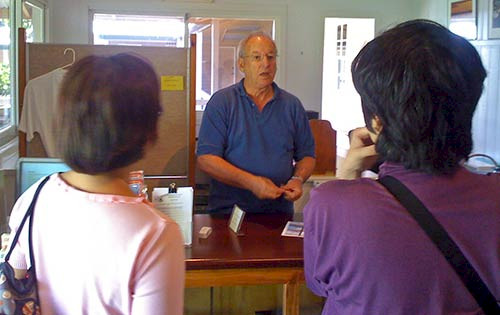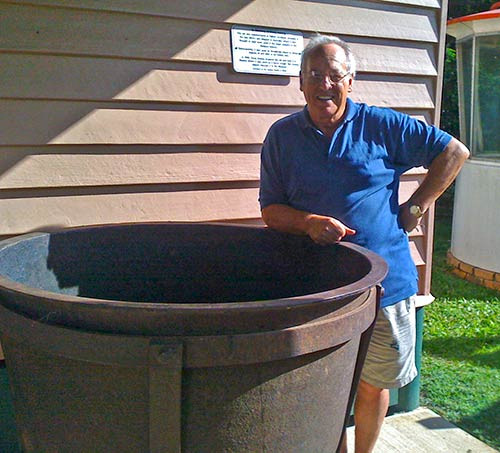Dugong oil vat, sand mining and Geoff Moore
Bill Dennison ·As part of Anzac (Australian and New Zealand Army Corps) Day celebrations to commemorate war veterans, the North Stradbroke Island Historical Museum hosted Anzac biscuits and tea on their wide veranda. After the festivities had died down, I ran into Geoff Moore who has been volunteering at the museum. Geoff was the CEO of Consolidated Rutile Limited, the sand mining company on the island when I was working at the University of Queensland. Geoff retired and has a house in Dunwich so he has been helping out at the museum, serving as Museum President. The museum won the 2009 Radio National Award for the best regional museum in Australia and also won the inaugural John Oxley Library Community Heritage Award for 2010, for the Online Heritage Trail.

Geoff told the story of the large cast iron vat that the museum recently acquired. The vat was made in Falkirk, Scotland between Edinborough and Glascow. It was shipped to Australia and used at one of the first sugar mills in Australia which was located at Hope Island, on the Gold Coast of Southeast Queensland. It was then taken to North Stradbroke Island where it was used for eighty years to render dugong oil and later to tar fishing nets. Dugong were hunted in Moreton Bay both by aborigines for meat and by Europeans for oil. Doug Anning was the butcher on the island for many years and was instrumental in saving the vat from scrap iron. He retired to a farm in Maleny about 40 years ago and took the vat. Doug died about two years ago but asked before he died that the vat be returned to the Island. Brother Nev has been at Maleny for most of his time and is still very much alive in his nineties and running a paint horse farm of some international repute. About 30 or 40 years ago the vat was relocated to Nev's farm and used as a horse trough and grew water lilies. Nev is an amazing character, a stalwart of the Peachester Historical Society, to which he has contributed many artefacts. The most significant are his art works from his time as a Prisoner of War in Singapore and the Burma Railway. Nev did most of the work moving the vat which weighs 7-8 hundredweights (one hundredweight is 112lbs even in the US!) from his steep paddock (all paddocks are steep at Peachester) and into Geoff's hire truck. Geoff hauled it back to the island and manhandled it to its present position. Nev has a direct connection to Cleveland (the mainland town with ferry access to North Stradbroke Island) through the PoW group who include a number of locals who were on the Burma Railway. They meet regularly in Cleveland with their supervising officer, Norm Dean, who was President of the Redland Museum in Cleveland for 30 years, and a very strong supporter of the North Stradbroke Island Historical Museum. Norm helped keep everybody motivated and connected in relocating the vat.

The museum has a collection of Oodgeroo Noonuccal, formerly known as Kath Walker (1920-1993). Oodgeroo was a poet and an activist for aboriginal rights. She was born on Stradbroke Island and established an educational center to teach children about aboriginal history. The museum also has an exhibit about the days when Dunwich had a benevolent asylum. The original Point Lookout lighthouse is at the museum, and a large sperm whale skull is displayed.
The museum also has a history of sand mining, which started out with people using shovels on the beach to obtain the mineral rich sands. A replacement for lead in paint was needed after World War Two, so titanium dioxide was in high demand. In the heyday, there were 19 sand mines operating on the Australian coast from Newcastle, New South Wales to Stradbroke Island. The only remaining mine is on North Stradbroke Island.
Geoff and I talked about the controversy over the future of sand mining on Stradbroke Island. Premier Anna Bligh announced that the Queensland government was going to shut down the sand mine and convert Stradbroke Island to National Park. Anna brought her family over to North Stradbroke Island for the Easter holiday. Hundreds of locals turned out for a protest in support of the sand mine and Anna's husband was confronted by angry residents at a local shop.
Geoff Moore as a Straddie resident and a former sand mining engineer has a unique perspective on the issue of sand mining. Geoff said that the mining company had always anticipated winding down by 2025, and that the mining company helped preserve a large portion of the island. Creating increased public access on the island could lead to environmental degradation due to runoff from impervious surfaces (roads and roofs), increased erosion and nutrient inputs due to fertilizer use and septic systems. Something that was not stressed were the relevant uses of the heavy minerals obtained from the sand mining. Compared with coal mining which contributes to greenhouse gases and leaves large holes in the ground, sand mining for mineral sands does not remove large amounts of sand and can be revegetated.
We agreed that charting the future of North Stradbroke Island was a complex problem (see previous blog posts about sand mining and classifying problems). Geoff saw that the North Stradbroke Island Historical Museum is particularly important when the future of the island is being debated. As Winston Churchill said "The farther backward you can look, the farther forward you can see".
About the author
Bill Dennison

Dr. Bill Dennison is a Professor of Marine Science and Interim President at the University of Maryland Center for Environmental Science (UMCES).